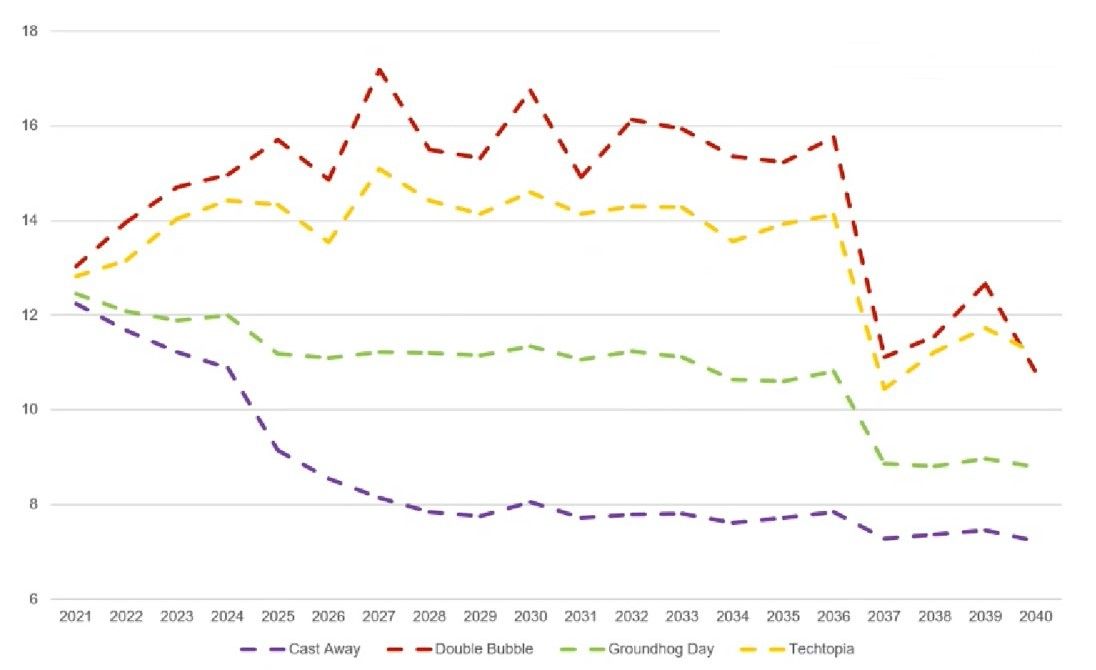🗡️ Who murdered the Murujuga rock art science?
Special Cluedo™️ edition 🔍 Was it Mr Cook or Prof Smith?
The first cut at planning WA power's future ignores carbon costs that Woodside would estimate at many billions and comes nowhere near the WA Government's target of net-zero emissions by 2050.

The South-West electricity system will fall well short of the WA Government's goal of net-zero emissions by 2050 if a preliminary plan by the Energy Transformation Taskforce is any guide.
Carbon emission drops ranged from about 15 per cent to 43 per cent between 2020 and 2040 in four scenarios analysed, leaving an enormous task for the final decade of the 30-year journey.
Taskforce energy transformation implementation director Jai Thomas said the "sneak peek" of its Whole of System Plan presented at a webinar on Friday was "interim and preliminary findings only."
The Whole of System Plan is one of three major initiatives for the Taskforce as part of the WA Government's energy transformation strategy launched by Minister for Energy Bill Johnston in March 2019.
Taskforce independent chair Stephen Edwell said the plan was not biased to any particular technology.
"Clearly we want to open the door and break down barriers to new technologies, but we're agnostic in terms of the way to which the capacity mix involves," Edwell said.
"What you're really for in the WOSP is a reflection of the economics and the physics of the power system based on assumptions as we see them today."
Total electricity usage on the South West Interconnected System increased under all four scenarios. Power sold onto the grid, so-called operational demand, decreased in two scenarios as more consumers generated electricity with rooftop solar panels.

Whole of System Plan project lead Miles Jupp said the lowest-cost capacity mix was calculated for each scenario.
"The generation mix becomes more diverse, with far more renewables connecting across more areas, rooftop PV and other renewables displace thermal generation," Jupp said.
"Coal generation output declines while gas plays a greater role in firming intermittency and supporting renewables."
Renewable power increased by between about 39 per cent and 44 per cent by 2030, according to plots presented at the webinar.
Power from gas-fired generators also increased in at least three of the scenarios.

Carbon emissions in 2040 reduced by up to about 43 per cent under the two scenarios with no operational demand growth. However, total emissions dropped by only about 15 per cent in the other two scenarios.
Jupp said the modelling put no value on carbon emissions.
The current absence of a carbon price, or any other effective restriction on greenhouse gas emissions, in Australia has not stopped private investors assuming the situation will change in the future.
Just weeks ago, Woodside, a company with a keen interest in and influence over environment policy in WA, doubled the carbon price it used to assess investments to $US80 a tonne.
"If you are really targeting 1.5℃ you need to be around that $US80 a tonne longer term," Woodside chief executive Peter Coleman said.
A target of net zero emissions by 2050, tentatively embraced by the WA Government as an "aspiration" in August 2019, is based on what is required to limit global heating to 1.5℃.
The lowest emissions predicted by the preliminary WOSP is about 7.2 million tonnes of CO2e in 2040 under the Cast Away scenario of muted economic growth.
Woodside would price the costs of just that 12 months of emissions at $800 million: an enormous amount that clearly would sway investment choices on the SWIS.
The cost would be many billions over the next 20 years, and even more for other scenarios.
Edwell said the Taskforce did not analyse a scenario that achieved net-zero emissions as it was not a Federal Government target.
"What it (the plan) tells government is that if you just let the economics go and you don't have any interventionist policies this is where you end up," Edwell said.
"How government takes that information and carries it forward is really a matter for government."
Boiling Cold asked the Minister for Energy Bill Johnston why he did not ask the Taskforce to consider what was required to achieve net-zero emissions by 2050.
"It's just a modelling tool, and the Government will respond to the Whole of System Plan when it's complete," Johnston said.
The questions about achieving net-zero emission by 2050 were not answered.
The Taskforce expects to deliver the final plan to Johnston in September.
The WA Government announced in December 2018 that it would develop a new climate change policy.
Minister for Environment Stephen Dawson said work on the policy, paused while the Government managed the COVID-19 pandemic, has recommenced and he expected the policy to be released this year.
Main image: new electricity supply chain graphic. Source: Energy Policy WA website
All the info and a bit of comment on WA energy and climate every Friday